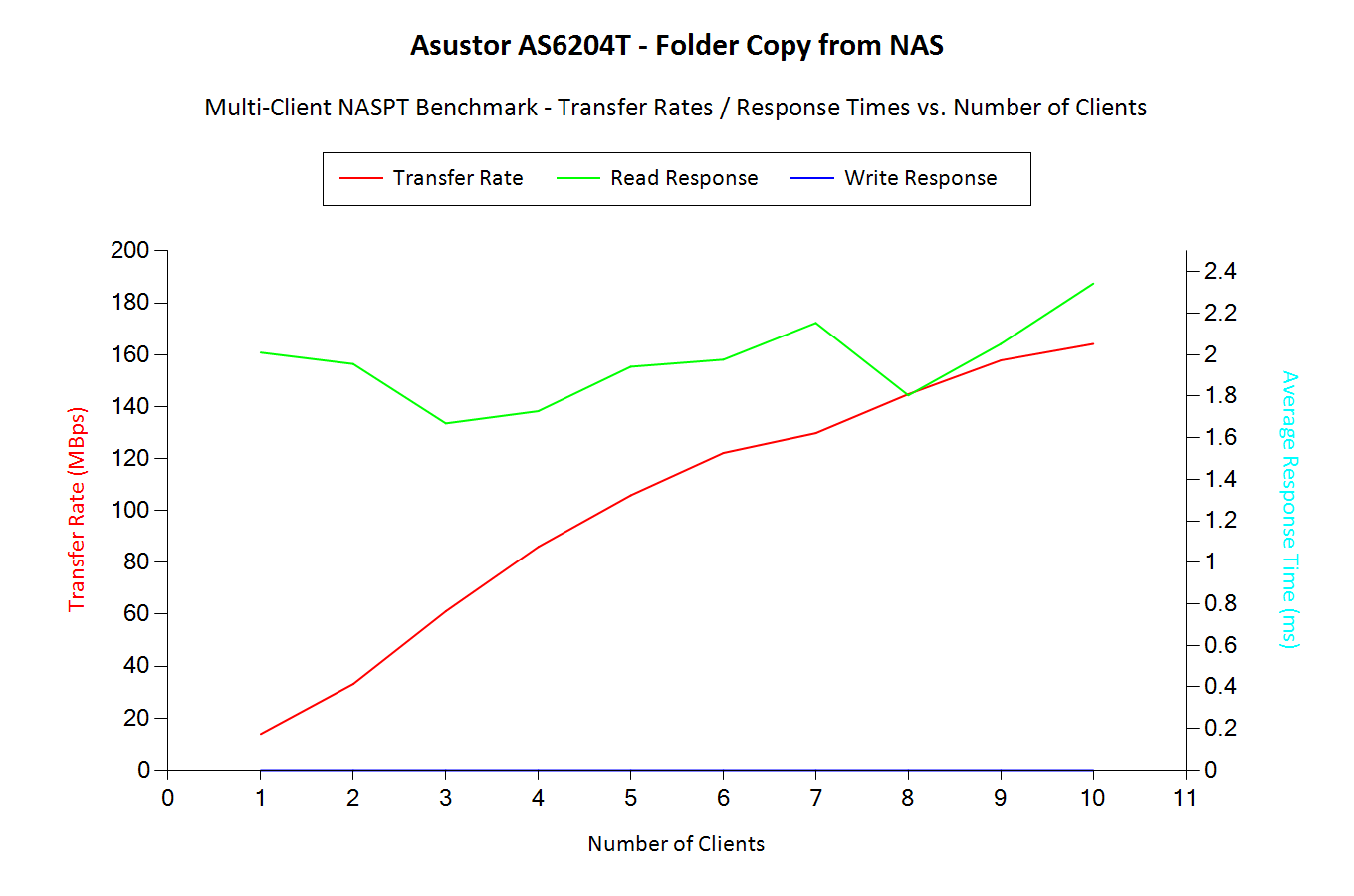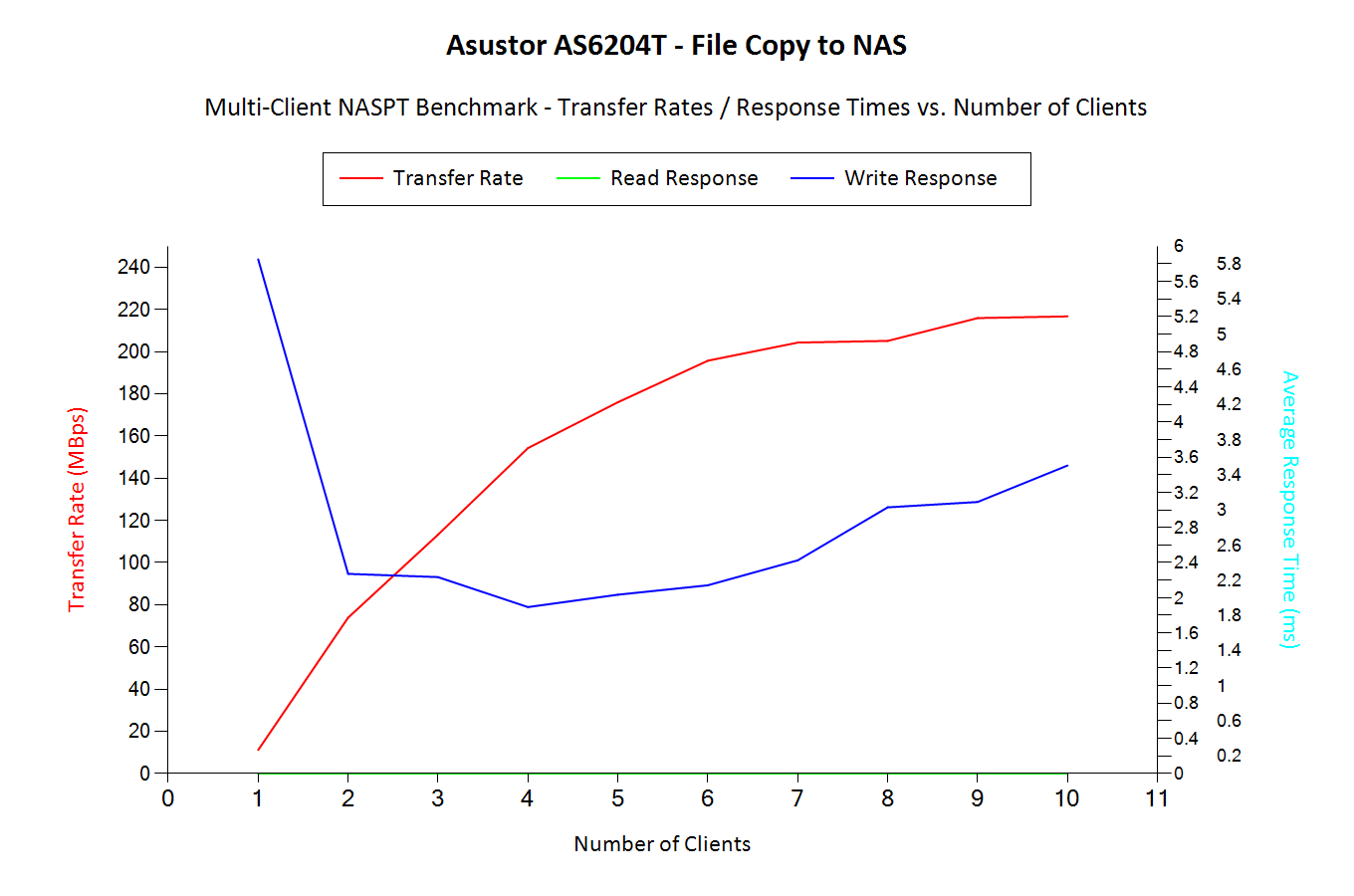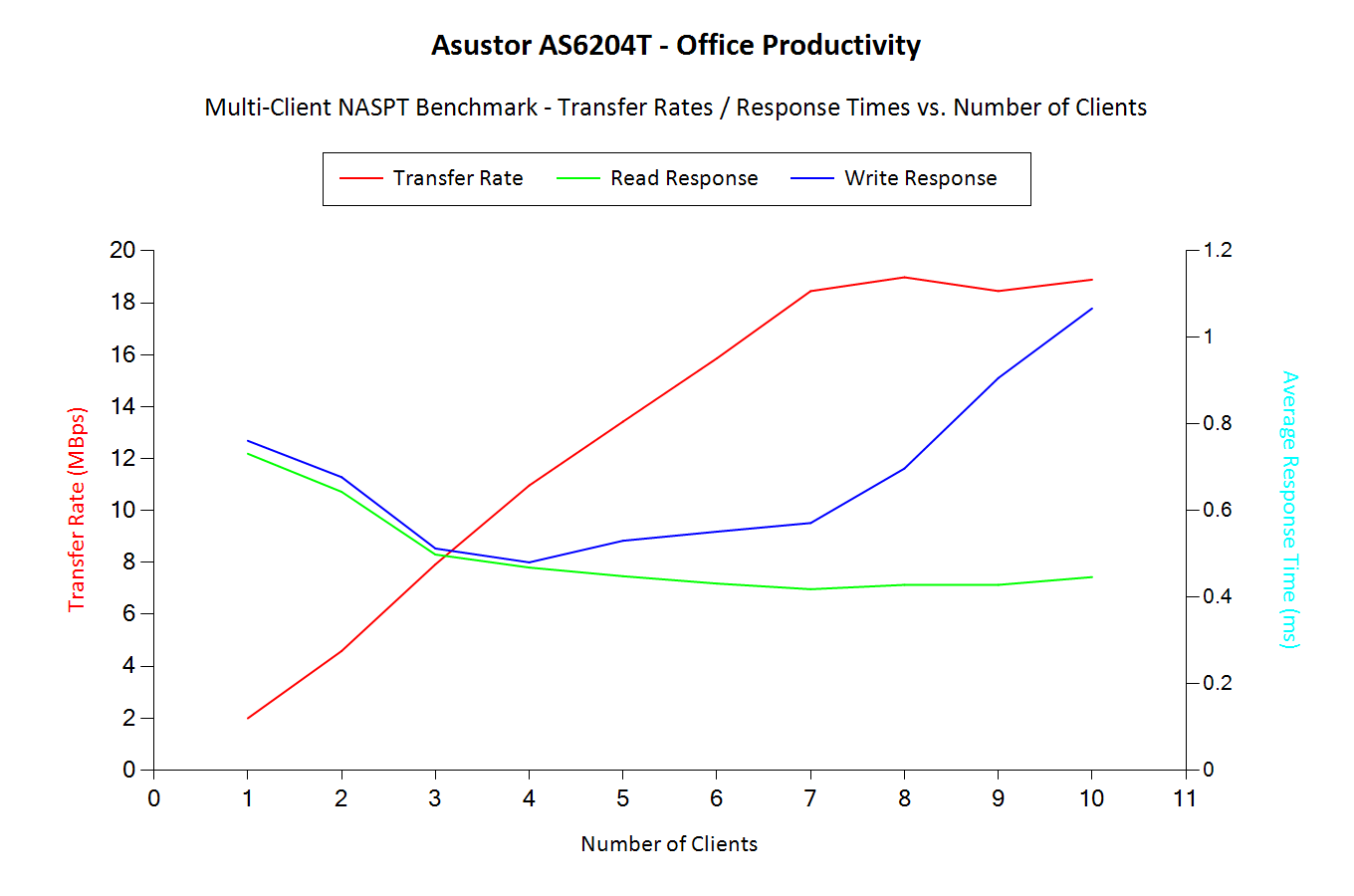Asustor AS6204T Braswell NAS Review
by Ganesh T S on November 5, 2015 8:00 AM ESTMulti-Client CIFS Performance for Consumer Workloads
The workloads experienced by a NAS unit in a typical home consumer setting have changed quite a bit over the last few years. Multiple mobile devices in a typical household raise the possibility that a NAS could be subject to the streaming out of multiple video files simultaneously. The popularity of IP cameras also make it necessary for NAS units to be able to record multiple video streams at the same time.
In our previous NAS reviews, we evaluated multi-client scenarios using synthetic workload traces and IOMeter. While there is nothing wrong in presenting numbers from such benchmarks, the reader is often left confused as to what those numbers might mean for his particular use-cases. Intel's NASPT benchmarking program gives us a good idea of the performance of the NAS unit when accessed by a single client. We took the source code of Intel's NASPT along with the supplied application traces and tweaked them to be able to run from more than one Windows client simultaneously in a co-ordinated manner. The graphs below present the results from tracking various metrics during the course of the benchmark runs. It must be noted that the average service times refer to what is obtained for all the traces when some of the data has already been cached in the client's memory. Unfortunately, NASPT doesn't provide any sort of guideline on what the optimal bandwidth and service times are for a good user experience.
Content Creation
The Content Creation workload seems to get acceptable performance for up to 5 clients. Beyond that, the per-client bandwidth numbers start to plateau / get worse, and the average response time also starts ramping up steeply. The drop-down at the bottom of the graph shows other comparison points. We find that the QNAP TS-451+ can support an additional client and provide better per-client bandwidth for the same workload. The detailed table with a breakdown of all the throughput numbers as well as the service times is available here

Folder Copy from NAS
The Folder Copy from NAS workload seems to get acceptable performance across the maximum number of clients that we tested (10). In this workload, we actually see that the AS6204T can perform better than the QNAP TS-451+. The detailed table with a breakdown of all the throughput numbers as well as the service times is available here

Folder Copy to NAS
The Folder Copy to NAS workload seems to get acceptable performance for up to 7 clients. Beyond that, we have a steep spike in the average response time. The QNAP TS-451+ performs better in this write-intensive workload. The detailed table with a breakdown of all the throughput numbers as well as the service times is available here

File Copy from NAS
The File Copy from NAS workload doesn't trouble the AS6204T. It gets acceptable performance across all tested clients (10). Unlike the QNAP TS-451+, the AS6204T is able to almost saturate the dual GbE links in this read-intensive workload. The detailed table with a breakdown of all the throughput numbers as well as the service times is available here

File Copy to NAS
The File Copy to NAS workload doesn't pose any problems to the AS6204T across the maximum number of clients we tested (10). The performance is actually neck-and-neck with the QNAP TS-451+ as we increase the number of clients. The detailed table with a breakdown of all the throughput numbers as well as the service times is available here

HD Video (1x) Playback
The HD Video (1x) Playback workload is read-intensive, and, as we have seen from previous workloads, the AS6204T is able to easily surpass the QNAP TS-451+ both in terms of nett bandwidth as well as lower average response times. In fact, a little bit of caching on the clients side actually enables apparent saturation of the network links. The detailed table with a breakdown of all the throughput numbers as well as the service times is available here
-Playback.png)
HD Video(1x) Playback and Record
The HD Video(1x) Playback and Record workload involves both reads and writes. The full-duplex nature of the network links enables the total bandwidth to be more than 300 MBps for this workload. Performance is better than the QNAP TS-451+ across all metrics for this workload. The detailed table with a breakdown of all the throughput numbers as well as the service times is available here
-Playback-and-Record.png)
HD Video (1x) Record
The HD Video (1x) Record workload fares similarly in both the AS6204T and the QNAP TS-451+. This write-intensive workload comes close to saturating the network links for both systems. The detailed table with a breakdown of all the throughput numbers as well as the service times is available here
-Record.png)
HD Video (2x) Playback
The HD Video (2x) Playback workload pulls the AS6204T ahead of the QNAP TS-451+ as the number of read streams increases. The network links are close to saturation in the Asustor case. The detailed table with a breakdown of all the throughput numbers as well as the service times is available here
-Playback.png)
HD Video (4x) Playback
The HD Video (4x) Playback workload behaves similar to the 2x playback workload. The AS6204T performs better than the QNAP TS-451+ in this case. The detailed table with a breakdown of all the throughput numbers as well as the service times is available here
-Playback.png)
Office Productivity
The Office Productivity workload seems to get acceptable performance for up to 7 clients. Beyond that, we have a noticeable drop in the per-client bandwidth numbers and a ramp in the response times. The QNAP TS-451+ is able to easily surpass the AS6204T in this IOPS intensive workload. The detailed table with a breakdown of all the throughput numbers as well as the service times is available here

Photo Album
The Photo Album workload seems to get similar performance for both the AS6204T as well as the QNAP TS-451+. All 10 clients seem to get acceptable performance. However, the average write response times for the AS6204T are a bit higher compared to the QNAP TS-451+. The detailed table with a breakdown of all the throughput numbers as well as the service times is available here

The detailed logs from the processing of our benchmarks - inclusive of metrics such as the file open times for each workload on each of the clients - can be found here










29 Comments
View All Comments
extide - Thursday, November 5, 2015 - link
I think Purch could handle that expense. Anandtech isn't a little teensy website anymore, remember.DanNeely - Thursday, November 5, 2015 - link
Unless your preferred solution is either the Toms Hardware (picked on only because I'm not sure what else Purch already owns) comment system reskinned to Anandtech colors or something completely off the shelf like Discuss; that might not be the best idea. I'm very leery of handing the job off to a corporate overlord who bought the site on the assumption of being able to pull extra money out of it and which has already triggered multiple complaints from readers about overly intrusive advertising.milkod2001 - Thursday, November 5, 2015 - link
You could possibly contact Purch: http://purch.com/#contact-general(It own this website) and request it there. For such reputable company it is shame there is not edit option. It should not take more then 1 day to implemented it or just install DISQUS
Namisecond - Monday, December 7, 2015 - link
Don't underestimate the time it may take to transfer all the user accounts over. If the tools work fine and everything goes well in a single pass, it could take a day. If there are serious problems, might take several days to over a week.extide - Thursday, November 5, 2015 - link
Perhaps it refers to the number of dual-core modules -- as that is how Intel builds those chips (in dual-core pairs)dtgoodwin - Thursday, November 5, 2015 - link
Please, please, could you review a moderately configured FreeNAS setup testing it the same way you do these? I know there are a tremendous amount of variables, and tuning available, but if you used the standard configuration of software, and chose a medium performance platform such as an i3, or core series Pentium or Celeron and tested it with 4 drives, it could be comparable.I run a 7 drive RAIDZ2 with 3TB WD REDs. I am almost always able to saturate a single GB link using CIFS and robocopy or Windows file copy whether reading or writing. I'm running a less than optimal setup as I have 15 TB of usable space, but only 8GB of RAM. My system with a SuperMicro board with ICMP, 2 GB NICs, a Pentium G2030, and a used SuperMicro case cost me about $650 not including the drives.
Black Obsidian - Thursday, November 5, 2015 - link
I'm sure they could write such a feature, but the first 17 pages would be component selection, installation, lexicon (vdev, pool, stripe size, etc.), Shell Commands 101, and so forth.And none of it would say anything new. Anyone running--or considering running--FreeNAS knows its performance capabilities, and anybody seriously considering a Synology/QNAP/Asustor product is going to be in a coma by the third page of such a feature.
DanNeely - Thursday, November 5, 2015 - link
They wouldn't have to write those pages if they didn't want to. Just set general requirements and ask the hardware partners to donate a build as usual; or punt farther and get an entry level prebuilt freenas box from that company that's been selling them for years (albeit at a price that makes Synology/QNAP boxes look cheap). Default to RAIDZ5 to maintain parity with the rest of their 4 bay NAS reviews. Stick to setting it up via the installer/web config panel. The whole point of a product like freenas vs roll your own is that for typical nas use cases the user should never need to drop down to the shell or need to understand all of the magic behind the scenes. A single page on what ZFS does better than ETX4 on most linux based nases is really all that's needed.Navvie - Friday, November 6, 2015 - link
HP Microserver G1620T. Upgrade RAM to 8GB. Hardware selection done.FreeNAS/nas4free on USB stick. Default ZFS options that the web interface presents.
AnandTech seems to be making a big thing of NAS devices these days, ignoring the build your own device option is silly. Even if somebody is set on buying an off the shelf unit, it would be nice to see how much better it performs (or not) compared to a BYOD.
DCide - Thursday, November 5, 2015 - link
For some reason Asustor always reminds me of the words stupid or stupor. Probably not ASUS' finest branding moment.